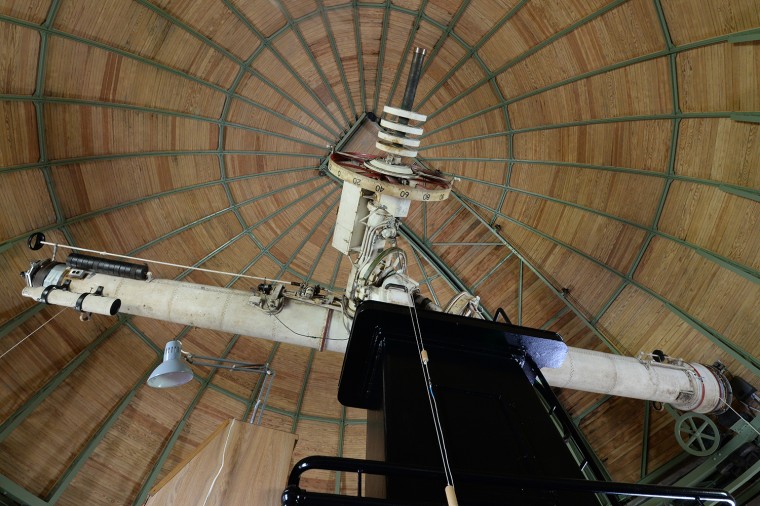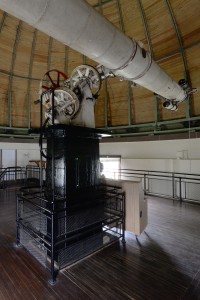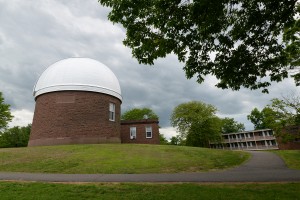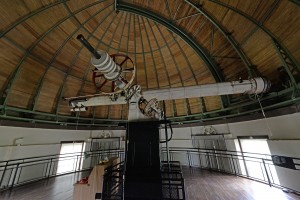Antique Van Vleck Refractor Telescope to Get a Facelift


Beginning June 2, the nearly century-old 20-inch Van Vleck Refractor, which lives on Foss Hill in its iconic dome, will get a complete facelift to return it to full working order. The rare historic telescope will be dismantled, cleaned, repaired, reassembled and modernized over a period of about 15 months in preparation of the observatory centennial in 2016. (View several photos of the renovation here.)
The work will be done by Fred Orthlieb, Ph.D. and Chris Ray, members of the Antique Telescope Society who run a company called Ray Museum Studios. Based in Swarthmore, Penn., they are well-regarded experts in the highly-specialized field of antique telescope restoration; Orthlieb is the Isaiah V. Williamson Professor of Civil and Mechanical Engineering at Swarthmore College.

The refractor has been deteriorating gradually since its retirement from research around 1993, according to Bill Herbst, the John Monroe Van Vleck Professor of Astronomy, chair of Astronomy, director of the Van Vleck Observatory, and director of graduate studies. Still, Herbst said, “I hope I’m in as good shape when I’m 100!”
Refracting telescopes have a “great big lens” that light goes through, and thus can only be supported around the edge, Herbst explained. In contrast, modern day telescopes reflect light like a mirror, and are designed more compactly with support along the whole back side.
“The frame we need to hold the 20-inch telescope is massive and long. That’s why it needs a big dome like the one we have on Foss Hill,” said Herbst. Despite these limitations, he said, “Refracting telescopes give you the most beautiful views through them because they have the cleanest optics; the highest resolution. They’re very good for looking at planet surfaces.”

In recent years, the refractor has remained in use by approximately 1,000 visitors annually. The Astronomical Society of Greater Hartford leads monthly trips to the telescope for observation and teaching, and Wesleyan offers access to visitors on special occasions such as Reunion and Commencement and Homecoming/Family Weekend. Wesleyan classes also use it from time to time, though Herbst said students must be accompanied by an experienced assistant.
The 20-inch lens originally was ordered from the Alvan Clark company, a famous lens maker in Mass., about a century ago, but installation in the observatory was not completed until 1922 due to delays associated with World War I. It has been used continuously since then, and has been a part of many important contributions to astronomy. In the 1950s, it was regularly used by Walter Scott Houston to observe “Deep Sky Wonders” for his column of that name written for Sky & Telescope Magazine. In the 1960s and 1970s, it was used by Professor Heinz Eichorn and others to demonstrate that a claimed planet around Barnard’s star did not exist. Its scientifically productive life extended well into the 1990s as it was used by Professor Arthur Upgren and his team to obtain distance measurements to nearby stars by the parallax method. These were the first steps on the ladder of the cosmic distance scale that establishes the size and age of the Universe.

The Van Vleck refractor is one of three visible light telescopes housed on Foss Hill. There is also a radio telescope on the observatory roof. Wesleyan also has several smaller, portable telescopes. The Astronomy Department’s very first telescope, purchased in 1836 by Wesleyan’s first president Willbur Fisk and used until the 1980s, remains on display in the observatory’s foyer.
According to Herbst, many of the problems with the refractor today stem from modernizations to the telescope that were done poorly in the 1960s.
Now, he said, “It’s going to be restored to be more like its original nature, except that it will be modernized to become computer controlled. This will make it much more efficient for use by students and the public, and it will make it possible for us to have the telescope open on many more nights.” Herbst added that they plan to have Wesleyan students supervise this use.
After restoration, it is believed the telescope will be usable for at least another 100 years. The Astronomy Department hopes it will continue to be the focus of an active public outreach program with even more hours of availability for viewing to the Wesleyan and Greater Middletown communities.

